 |
Photography, Australian Landscape Photography, Panoramic Photos, |
 |
Photography, Australian Landscape Photography, Panoramic Photos, |
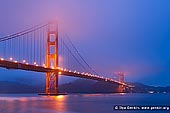 |
| The Golden Gate Bridge Early in the Morning US-SAN-FRANCISCO-GOLDEN-GATE-0001 |
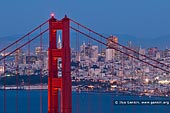 |
| Thread the Needle - The Golden Gate Bridge US-SAN-FRANCISCO-GOLDEN-GATE-0002 |
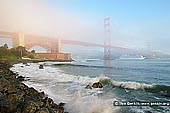 |
| The Golden Gate Bridge in Fog at Sunrise US-SAN-FRANCISCO-GOLDEN-GATE-0003 |
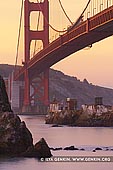 |
| The Golden Gate Bridge at Twilight US-SAN-FRANCISCO-GOLDEN-GATE-0004 |
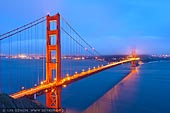 |
| The Golden Gate Bridge after Sunset US-SAN-FRANCISCO-GOLDEN-GATE-0005 |
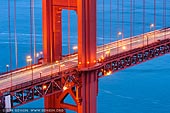 |
| Close-up View of The Golden Gate Bridge US-SAN-FRANCISCO-GOLDEN-GATE-0006 |
The Golden Gate Bridge is a suspension bridge spanning the Golden Gate, the opening of the San Francisco Bay into the Pacific Ocean. As part of both U.S. Route 101 and California State Route 1, the structure links the city of San Francisco, on the northern tip of the San Francisco Peninsula, to Marin County. It is one of the most internationally recognized symbols of San Francisco, California, and of the United States. It has been declared one of the modern Wonders of the World by the American Society of Civil Engineers. The Frommers travel guide considers the Golden Gate Bridge 'possibly the most beautiful, certainly the most photographed, bridge in the world'. Construction of the Golden Gate Bridge began in 1933 and was completed in 1937. It makes a vital connection from city of San Francisco to Marin County. Prior to the construction of the bridge, the only way to commute was by Ferry. This caused an immense amount of harbor traffic and clogged the waterways. Then, in the 1920s, an engineer and bridge builder named Joseph Strauss, suggested that a bridge be built to span the Golden Gate. It was the time of economic uncertainty and the 'Great Depression'. Because of such an enormous undertaking, Strauss faced many groups who opposed his idea. Not only was the country financially stressed, but another bridge, the 'San Francisco Bay Bridge' was already under construction. Many other engineers in the field were also opposed to the project, believing that it could not physically be built and the cost would be far more than anticipated. Strauss continued his efforts and in 1923 with the help of local legislators, the 'Association of Bridging the Gate' was formed. The funding for the bridge became available when voters approved $35 million dollars in bonds to begin construction of the bridge. Strauss believed that although many opposed his idea, the building of the bridge would relieve water traffic across the straight and would eventually pay for itself in tolls. And so it was that construction of the Bridge began on January 5, 1933. After four years of construction the Golden Gate Bridge opened for traffic on May 28, 1937. For 27 years from its completion in 1937, the Golden Gate Bridge had the longest main span of any bridge in the world (surpassed in 1964 by the Verrazano-Narrows Bridge in New York City). The main span, which runs 4,200 feet long, is suspended from two cables hung from towers 746 feet high, and at midpoint the roadway is 265 feet above mean high water. Soon after its completion the Golden Gate Bridge already enjoyed worldwide fame, not only because the bridge was breaking records, but also thanks to the elegant Art Deco design of the two huge towers and the magnificent surroundings near the Pacific Ocean. The eye catching orange-red color of the bridge also helped its popularity. The color was suggested by engineer Irving Morrow, who thought the traditional gray color was too boring. The Golden Gate Bridge has now long lost its record of the longest bridge, but it is still one of the world's most famous structures. Today, people from all over the world come to photograph and experience this magnificent masterpiece and unique work of art. They too understand what this symbol of California and America called 'The Golden Gate Bridge' means. It is one of the most photographed man made objects in the world: And for the tourist, to go home without a photo of 'her' in the background, is like never having been to San Francisco. She is a tribute to the American Pioneer Spirit and the challenge of making the impossible, happen. Even though there is a sidewalk on the Golden Gate Bridge, it's quite a challenge to cross the bridge. Not only is it almost 3km long, but it is a breathtaking 67 meter (220ft) above sea level. In extreme circumstances the bridge can sway almost 28ft (8 meter). This makes the bridge less sensible to external forces such as strong winds and earthquakes but it can make the crossing rather unpleasant. The views however are amazing. An alternative to crossing the bridge on foot is driving by car - but don't forget you'll have to pay toll - or you can take one of the busses that connect San Francisco with Marin County. There is a bus stop right at the start of the bridge. The Golden Gate Bridge is located at the Presidio Park and can easily be reached by bus or car. The most pleasant way to reach the bridge however is by walking either from the Marina District to the east or from Baker Beach to the west of the bridge. Both routes will lead you through a park, and especially the route along the east is very popular. The Golden Gate Bridge is a spectacular sight which can be seen from many areas around San Francisco. Here are some locations from where you have great views on the bridge:
|